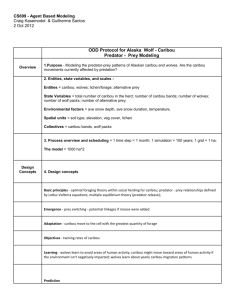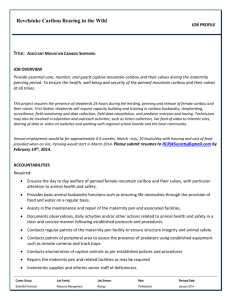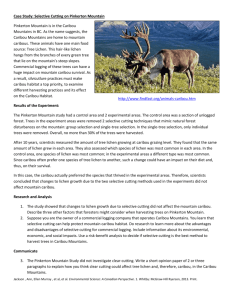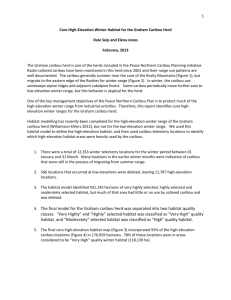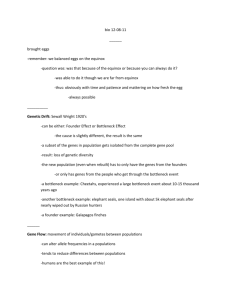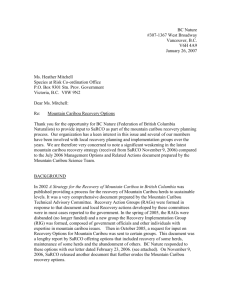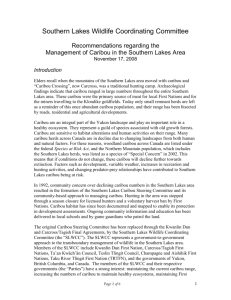Wolf-caribou-briefing-document-final
advertisement
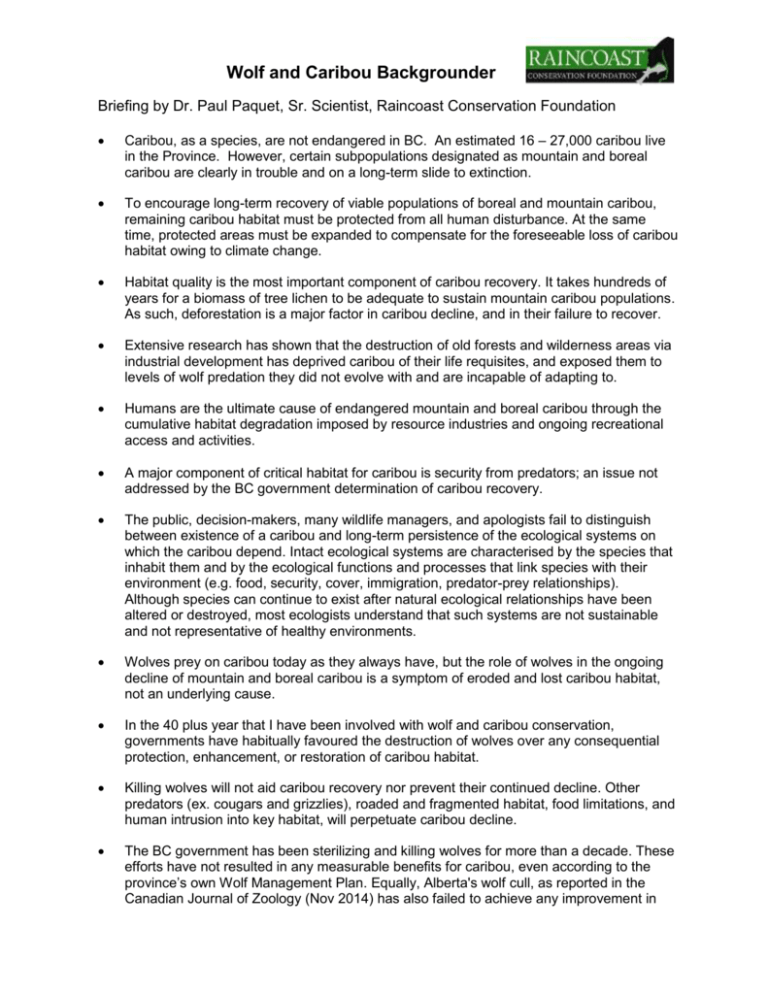
Wolf and Caribou Backgrounder Briefing by Dr. Paul Paquet, Sr. Scientist, Raincoast Conservation Foundation Caribou, as a species, are not endangered in BC. An estimated 16 – 27,000 caribou live in the Province. However, certain subpopulations designated as mountain and boreal caribou are clearly in trouble and on a long-term slide to extinction. To encourage long-term recovery of viable populations of boreal and mountain caribou, remaining caribou habitat must be protected from all human disturbance. At the same time, protected areas must be expanded to compensate for the foreseeable loss of caribou habitat owing to climate change. Habitat quality is the most important component of caribou recovery. It takes hundreds of years for a biomass of tree lichen to be adequate to sustain mountain caribou populations. As such, deforestation is a major factor in caribou decline, and in their failure to recover. Extensive research has shown that the destruction of old forests and wilderness areas via industrial development has deprived caribou of their life requisites, and exposed them to levels of wolf predation they did not evolve with and are incapable of adapting to. Humans are the ultimate cause of endangered mountain and boreal caribou through the cumulative habitat degradation imposed by resource industries and ongoing recreational access and activities. A major component of critical habitat for caribou is security from predators; an issue not addressed by the BC government determination of caribou recovery. The public, decision-makers, many wildlife managers, and apologists fail to distinguish between existence of a caribou and long-term persistence of the ecological systems on which the caribou depend. Intact ecological systems are characterised by the species that inhabit them and by the ecological functions and processes that link species with their environment (e.g. food, security, cover, immigration, predator-prey relationships). Although species can continue to exist after natural ecological relationships have been altered or destroyed, most ecologists understand that such systems are not sustainable and not representative of healthy environments. Wolves prey on caribou today as they always have, but the role of wolves in the ongoing decline of mountain and boreal caribou is a symptom of eroded and lost caribou habitat, not an underlying cause. In the 40 plus year that I have been involved with wolf and caribou conservation, governments have habitually favoured the destruction of wolves over any consequential protection, enhancement, or restoration of caribou habitat. Killing wolves will not aid caribou recovery nor prevent their continued decline. Other predators (ex. cougars and grizzlies), roaded and fragmented habitat, food limitations, and human intrusion into key habitat, will perpetuate caribou decline. The BC government has been sterilizing and killing wolves for more than a decade. These efforts have not resulted in any measurable benefits for caribou, even according to the province’s own Wolf Management Plan. Equally, Alberta's wolf cull, as reported in the Canadian Journal of Zoology (Nov 2014) has also failed to achieve any improvement in Boreal Caribou adult female survival, or any improvement in calf survival. As such, it had no effect on population dynamics. Killing wolves is not a 'one time solution'. Wolf culls involve killing hundreds of wolves, and over the longer term (as necessary to re-establish habitat), likely thousands of wolves. Predator control efforts can succeed in increasing prey populations only if sufficient habitat of adequate quality exists to support the expanded populations - that is, only when prey populations are well below the environmental carrying capacity. Many human activities harm wolves (both individuals and populations) in direct and indirect ways. Direct effects include culling by lethal methods as well as by sterilization, hunting, trapping, poisoning, and the destruction of food supplies. Indirect effects include changes to habitat or movement patterns that result in death or disrupt social relationships. Harmful direct actions have wide-ranging indirect effects. Killing some individuals in a wolf social group can disrupt the transfer of cultural and genetic information between generations, while simultaneously altering group stability and breeding structures. Culling disrupts pack cohesion and biologically short-changes landscapes that can benefit from the presence of wolves. Although direct harm is more obvious and more likely to attract public attention, both direct and indirect harm need to be recognised as important determinants of animal welfare and conservation. BC is one of two Canadian provinces that has not adopted the Canadian Council on Animal Care (CCAC) standards that guide the welfare and humane treatment of wild and domestic animals. As such, BC is not in accordance with this national standard. Fundamentally, manipulative conservation management should be well grounded in ecology and environmental ethics. Wolf culls have neither. Further, wolves are scapegoated in attempts to protect oil and gas, mining, and forestry activities. Wildsight’s John Berganske repeats speaking points that have long been dismissed as ecologically illiterate, as well as being ethical violations of the CCAC. About Dr. Paul Paquet Paul Paquet holds graduate degrees in philosophy, wildlife behavior and conservation, biology, and a Ph.D. in zoology from the University of Alberta. Paul is an internationally recognized authority on mammalian carnivores, particularly wolves. He has worked for decades on the relationship between wolves and their prey and on possible top-down effects from predators to prey. A research group lead by him recently described unique behavioural aspects of wolf predator-prey ecology in western Canada. Paul has been instrumental in describing the complexities of wolf management including characterizing wolf (sub)species, their ecology, and behaviour. He has published more than 200 scholarly articles and several books addressing these issues. Currently, Dr. Paquet is an Adjunct Professor of Geography at University of Victoria. Additional academic appointments include Adjunct Professor of Biology and Associate Professor of Environmental Design at the University of Calgary; Adjunct Professor at University of Saskatchewan College of Veterinary Medicine, Adjunct Professor of Biology at Brandon University, Adjunct Professor of Zoology at University of Manitoba; and Faculty Associate at Guelph University, and University of New Brunswick. He is also a member of government, industry, and advisory committees of organizations such as Environment Canada, US Fish & Wildlife Service, Caribou Scientific Advisory Committee for Saskatchewan, WWF International, the European Union, and International Union for Conservation of Nature (IUCN) Canid Specialist Group.
